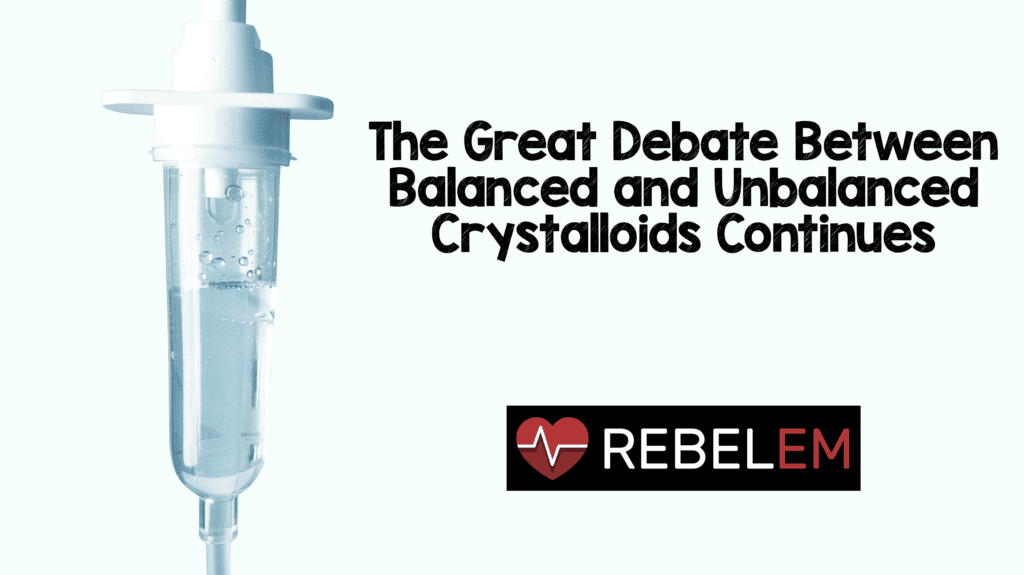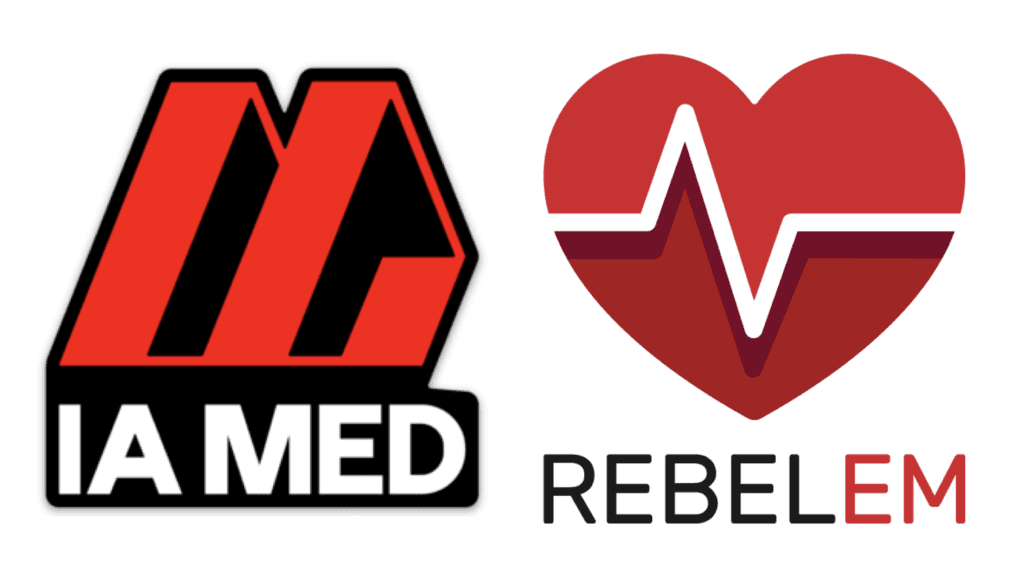
 Background: Although the debate over balanced (i.e. lactated ringers, PlasmaLyte) vs unbalanced (i.e. 0.9% saline) crystalloids has not been settled, fluid resuscitation continues to be a fundamental therapy given to critically ill patients. 0.9% saline is one of the most common fluids given in resuscitation of patients but the high chloride content may contribute to the development of acute kidney injury (AKI) [1]. Alternatives to 0.9% saline include crystalloids with electrolyte compositions that are more balanced and resemble that of plasma (i.e. Lactated Ringer’s Plasma-Lyte, etc). Theoretically use of more balanced crystalloids would result in less potential side effects when compared to 0.9% saline. The crux of the matter is does fluid choice affect any patient-oriented outcomes?
Background: Although the debate over balanced (i.e. lactated ringers, PlasmaLyte) vs unbalanced (i.e. 0.9% saline) crystalloids has not been settled, fluid resuscitation continues to be a fundamental therapy given to critically ill patients. 0.9% saline is one of the most common fluids given in resuscitation of patients but the high chloride content may contribute to the development of acute kidney injury (AKI) [1]. Alternatives to 0.9% saline include crystalloids with electrolyte compositions that are more balanced and resemble that of plasma (i.e. Lactated Ringer’s Plasma-Lyte, etc). Theoretically use of more balanced crystalloids would result in less potential side effects when compared to 0.9% saline. The crux of the matter is does fluid choice affect any patient-oriented outcomes?
What They Did:
- Meta-analysis of randomized controlled trials comparing balanced crystalloids vs NS in critically ill patients
Outcomes:
- Primary: Mortality
- Secondary:
- Incidence of AKI
- Risk of receiving renal replacement therapy (RRT)
- ICU LOS
Studies Included:
- Population: Critically ill patients, ≥18 years of age requiring fluid resuscitation
- Intervention: Balanced crystalloids (i.e. Lactated Ringer’s, Hartmann, and Plasm-Lyte)
- Comparison: 0.9% Saline
-
Outcome Measure:
- Primary: Mortality
- Secondary: Incidences requiring RRT, incidence of AKI (AKI of stage 2 or higher
- Study Design: RCT
Exclusion:
- Patients with pre-existing chronic renal failure
- Patients younger than 18 years old
- Repeated data
- Fluids used as maintenance rather than resuscitation
Results:
- 9 RCTs (20,526 patients) identified
- Mortality (8 trials): No difference (RR = 0.93; 95% CI 0.86 – 1.01; p = 0.08)
- Incidence of AKI (7 trials): No difference (RR 0.94; 95% CI 0.88 – 1.00; p = 0.06)
- Receiving RRT (5 trials): No difference (RR 0.94; 95% CI 0.69 – 1.27; p = 0.67)
- ICU Length of Stay (6 trials): No difference (RR -0.31; 95% CI -1.60 – 0.97; p = 0.47)
Strengths:
- Used trial sequential analysis to determine whether the conclusions of the meta-analysis are reliable
- Used trial sequential analysis to determine whether the current evidence is robust and conclusive
- Literature search included multiple databases, limited to published studies in human subjects, randomized clinical trials, and did not have any language restrictions
- Two additional reviewers used to corroborate that data extraction was correct and accurate
- Quality of included trials was assessed by the Cochrane Risk of Bias Tool
- All included RCTs had low risk of bias in regard to random sequence generation (selection bias) and blinding of outcome assessment (detection bias)
- Largest meta-analysis to date on the topic of balanced crystalloids and NS
- Broke outcomes down into Plasma-Lyte vs NS and Lactated Ringer’s vs NS to ensure no differences in outcomes based on balanced crystalloid type
Limitations:
- Of the 9 randomized clinical trials included, 3 o the 9 trials only used 1000 – 1500cc of fluid in the 1st 24hrs which may dilute the results of the meta-analysis
- Unable to perform subgroup or sensitivity analyses meaning more studies are needed to evaluate the effect of different fluids on different patients and diseases
- Only evaluated mortality, AKI morbidity, RRT use, and ICU length of stay but did not evaluate incidence of hyponatremia or hospitalization costs
- Heterogeneity of patient populations (trauma, sepsis, acute pancreatitis, etc) with varying degrees of severity, could reduce the quality of results
Author Conclusion: “Among critically ill patients receiving crystalloid fluid therapy, use of a balanced crystalloid compared with normal saline did not reduce the mortality, risk of severe AKI, or RRT use rate. Further large randomized clinical trials are needed to confirm or refute this finding.”
Clinical Take Home Point: This meta-analysis contributes very little to the current discussion mainly because of the heterogeneity of included studies. The use of fluid type in different pathologies isn’t really what we need, but rather tailored use of fluids with patient-oriented outcomes. It appears the debate over balanced crystalloids and normal saline in the resuscitation of the critically ill will continue. Although it makes more physiological sense to use balanced crystalloids in large volume (>2L) resuscitation, at this point in time it appears if you are using NS or a balanced crystalloid as your resuscitation fluid of choice keep using your fluid of choice, and don’t worry about changing your practice, although some individual studies have shown advantages in some clinical situations, until more robust evidence pushes you to do so.
References:
- Yunos NM et al. Association Between a Chloride-Liberal vs Chloride-Restrictive Intravneous Fluid Administration Strategy and Kidney Injury in Critically ill Adults. JAMA 2012. PMID: 23073953
- Liu C et al. Balanced Crystalloids Versus Normal Saline for Fluid Resuscitation in Critically Ill Patients: A Systematic Review and Meta-Analysis with Trial Sequential Analysis. AJEM 2019. [Epub Ahead of Print]
For More Thoughts on This Topic Checkout:
-
REBEL EM: Is the Great Debate Between Balanced vs Unbalanced Crystalloids Finally Over?
Support the Show by Paying & Claiming 0.5hrs of CME/CEH by Clicking on the Logo Below
Post Peer Reviewed By: Anand Swaminathan, MD (Twitter: @EMSwami)
The post The Great Debate Between Balanced and Unbalanced Crystalloids Continues appeared first on REBEL EM - Emergency Medicine Blog.

